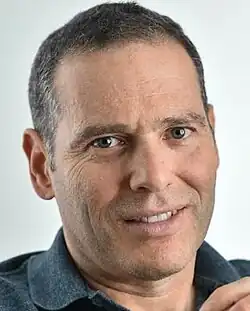Ron Kimmel
Ron Kimmel | |
|---|---|
רון קימל | |
 Ron Kimmel 2024 | |
| Born | |
| Nationality | Israeli |
| Known for | Geodesic Active Contours Image Segmentation Non-rigid shape analysis Computer aided diagnostics Intel RealSense technology |
| Awards | SIAM Fellow 2019 IEEE Fellow 2009 Helmholtz-Test of Time-Award 2013 |
| Scientific career | |
| Fields | Mathematics, Computer Science, Engineering |
| Institutions | Technion, UC Berkeley, Stanford |
| Doctoral advisor | Alfred Bruckstein, Nahum Kiryati |
Ron Kimmel (Hebrew: רון קימל; born 1963) is a professor of Computer Science and Electrical and Computer Engineering (by courtesy) at the Technion Israel Institute of Technology. He holds a D.Sc. degree in electrical engineering (1995) from the Technion and was a post-doc at UC Berkeley and Berkeley Labs, and a visiting professor at Stanford University. He has worked in various areas of image and shape analysis in computer vision, image processing, and computer graphics. Kimmel's interest in recent years has been non-rigid shape processing and analysis, medical imaging, computational biometry, deep learning, numerical optimization of problems with a geometric flavor, and applications of metric and differential geometry. Kimmel is an author of two books, an editor of one, and an author of numerous articles. He is the founder of the Geometric Image Processing Lab [1], and a founder and advisor of several successful image processing and analysis companies.
Kimmel's contributions include the development of fast marching methods for triangulated manifolds (together with James Sethian), the geodesic active contours algorithm for image segmentation, a geometric framework for image filtering (named Beltrami flow after the Italian mathematician Eugenio Beltrami), and the Generalized Multidimensional Scaling (together with his students the Bronstein brothers) with which he was able to compute the Gromov-Hausdorff distance between surfaces. He is one of the founders of the field of deep learning based computational oncology/pathology together with his student Gil Shamai.
In 2003, he appeared in an interview to WNBC on the use of geometric approaches in three-dimensional face recognition. In 2011, Intel acquired his cofounded company InVision. For ten years he played a leading role in the research and development of Intel RealSense technologies, as a part time Intel senior academic research fellow. In 2022 he cofounded Lumana.AI [2], where he serves as a chief scientific officer.
Work
Co‑Founder & Technical Lead, InVision (2010–2011)
Pioneered structured-light depth‑sensing technology transferred from the Technion's GIP lab. Insight into early RealSense prototypes based on these designs. [1],[2]
Distinguished Academic Researcher (Intel RealSense) (2011–2021)
Following Intel's acquisition of InVision in late 2011, Kimmel served in a part-time role equivalent to Intel Distinguished Fellow. He drove research and innovation that shaped the RealSense product line over a decade, culminating in widely adopted 3D vision systems.[2]
Co‑Founder & CSO, Lumana.AI (2022–present)
Co‑founded Lumana, focusing on advanced video analytics platforms. Currently holds the position of Chief Scientific Officer. [1]
Co‑Founder, CathAlert & VideoCites
Leveraged expertise in video analytics and computer vision to establish both companies, developing solutions for video‑based detection and content analysis. [1]
- Note: Many modern robotic platforms—such as Unitree GO2/H1, Boston Dynamics Spot, Xiaomi CyberDog, MIT Mini Cheetah, Agility Robotics Digit, and ANYbotics ANYmal D—integrate the RealSense sensors originating from Kimmel's work.
Refs
[2] "Intel R RealSense SR300 Coded light depth Camera TM - Technion"
Awards
- SIAM Fellow for contributions to shape reconstruction, image processing, and geometric analysis, 2019
- SIAG Imaging Science Best Paper Prize for SIAM J. Imaging Science'2013. Scale invariant geometry for non-rigid shapes, 2016
- Helmholtz Prize (ICCV Test-of-Time Award) for his 1995 paper on Geodesic Active Contours, 2013
- IEEE Fellow for his contributions to image processing and non-rigid shape analysis, 2009
- Counter Terrorism Award, 2003
- Henry Taub Prize, 2001
- Hershel Rich innovation award, 2001, 2003
- Alon Fellowship, 1998–2001
Books
- "Numerical Geometry of Images" published in 2003 by Springer
- "Numerical Geometry of Non-Rigid Shapes" (with Alex and Michael Bronstein) published by Springer in 2009.